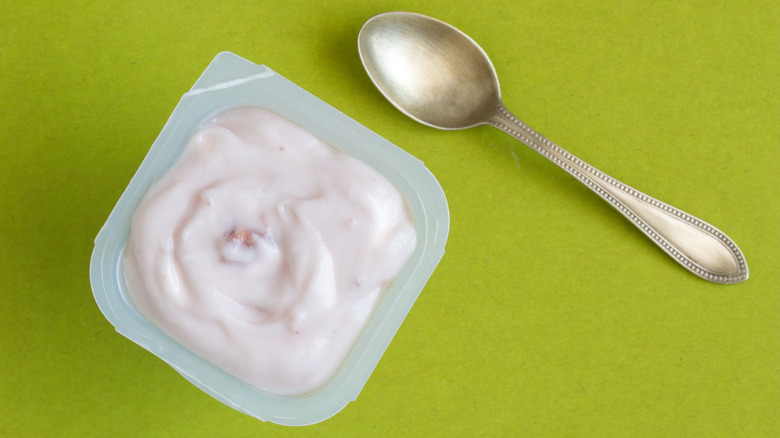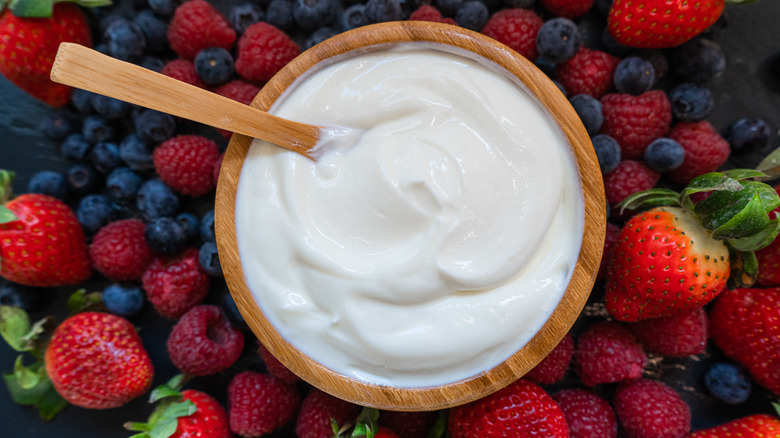The Last Day You Can Still Eat Yogurt After Opening It
So, you opened a tub of Greek yogurt six days ago and you're unsure if you should eat it. According to the U.S. Food and Drug Administration (FDA), it should be fine (as long as your fridge has consistently been at or below the standard 40 degrees Fahrenheit), since yogurt is usually safe to eat for one to two weeks. Some circumstances can alter the situation, however. For example, your yogurt shouldn't sit outside of the fridge for more than two hours during that time.
It's also smart to pay attention to the sell-by or use-by date on your yogurt and use this for guidance (if the date is in less than a week, consider eating the yogurt before then). Unfortunately, as with many things in life, yogurt is complicated and the sell-by date isn't an absolute indicator of whether the yogurt is still fine. These dates tend to indicate when the yogurt is at its best and freshest for consumption, rather than whether it's safe. That means that even if the sell-by date has passed, the yogurt might still be fine to eat within that one-to-two-week timeframe. If you're unsure, there are a few ways to inspect your yogurt and figure out if it's still good to eat.
How to tell if your yogurt is still OK to eat
Since there's not really one simple rule for knowing when yogurt is still good to eat, you can judge for yourself instead of relying on sell-by dates. Firstly (and most obviously), if there's mold on the yogurt, it belongs in the trash. The mold won't necessarily be a "classic" green color. It can be gray or pink.
Beyond mold, there are some other slightly less obvious signs of spoilage to look out for. If there's a lot of liquid floating around on top of the yogurt, that's one sign. That said, liquid on top of the yogurt isn't always a problem, except for Greek yogurt, due to Greek yogurt being thoroughly strained. Some liquid, which is protein-rich whey, is a normal component of yogurt. There's not really a concrete measure for what constitutes "too much" liquid but if there's a lot more liquid compared to when you first opened the yogurt, that might be a signal to pass on consuming the yogurt.
If you're unsure about the liquid situation, look for some other more obvious signs of spoilage. The big ones are if the yogurt has curdled or become clumpy: It should always have a smooth texture. Finally, give that yogurt a sniff: If it smells rancid or quite sour, that's a key sign that it's going bad. Yogurt should generally have a pretty neutral or nonexistent smell (of course, flavored yogurts might smell sweet).
What might happen if you eat spoiled yogurt
Fortunately, spoiled yogurt will usually taste pretty bad, so the chances of getting seriously sick from eating a lot of it aren't particularly high. That said, you might end up with some undesirable symptoms like vomiting, diarrhea, and nausea. The FDA notes that the risk is higher if your yogurt is made with raw, unpasteurized milk. This is relatively uncommon in the U.S. (and illegal in some parts), so it's probably not a concern if you're just buying popular brands at supermarkets. Fortunately, it's hard for nasty pathogens to develop in your standard pasteurized yogurt as the pasteurization wipes them out. The acidity of yogurt tends to prevent them from developing.
If you're concerned about your yogurt going bad before you eat it, you can freeze yogurt and it should be fine for one to two months. Be warned that the texture might not be so smooth once you thaw it, though. No matter how you treat it, time is of the essence with yogurt. Your senses are the best indicator of when that time is up.
How to use up leftover yogurt
If you have a decent amount of yogurt left in the container that you don't want to go to waste, don't toss it. There are many ways you can use up leftover yogurt before it goes bad. You could make creamy potato salad and substitute mayo for Greek yogurt. Or upgrade your mac and cheese with Greek yogurt, along with bacon and Panko breadcrumbs. Yum!
If you're craving something sweeter, try whipping up a stack of sweet potato pancakes (you'll replace the recipe's sour cream with Greek yogurt) or swap the eggs out for plain yogurt to upgrade simple boxed cake mix.
Can you freeze yogurt?
If you're unsure if you'll be able to finish a whole container of yogurt before it expires, you could freeze it either in an airtight container. If the container the yogurt came in is unopened, you could freeze it in that instead. Frozen yogurt is usually good for about two months before its taste and texture is truly affected. When you're ready to eat it, simply take the yogurt out of the freezer and place it in the fridge overnight to defrost. Be sure to stir the yogurt before serving it, as it may have separated.




